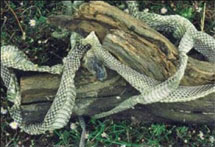

Wednesday - September 15, 2010
SLAC Today is
available online at:
http://today.slac.stanford.edu
In this issue:
SLAC Recycles Leftover Diesel
Snakes on a Plain
Seen around SLAC: A Model Laboratory
 |
 |
|
Wednesday - September 15, 2010 |
SLAC Recycles Leftover DieselNearly 4000 gallons of diesel fuel were drained
from this tank and sent for recycling. (Photo by Brad Plummer.)
In a continued effort to clear out and recycle unused materials, especially any that might pose a risk, SLAC's Facilities and Environmental Safety & Health Divisions worked together to successfully drain a tank of old diesel fuel on August 17. The fuel had been on site for about twenty years, and had been available as back-up for the boilers at Building 23. Recent tests showed that both the quality of the fuel and the integrity of the tank were not up to par. The tank has been out of service since 2009. It took about three hours to drain the nearly 4000 gallons of fuel from the tank. The fuel was sent to Veolia, an environmental services organization in Azusa, California, where it will be recycled in a process called fuel blending. The tank is scheduled for removal in the coming weeks. The operation comes just a few months after a lab-wide effort to recycle 76 tanks of highly flammable ethane gas, which had sat unused for nearly a decade. As with the ethane removal, the group was able to find an end user for the material. "We continue to reduce our unneeded hazardous material inventory and this is another great example," said ES&H Director Craig Ferguson. "And getting it in the hands of folks who can use it is great."  Shed snake skin at SLAC.
(Photo courtesy SLAC Facilities.) Snakes on a PlainAnd that plain is SLAC. An increased number of rattlesnakes have been spotted around the site recently. Due to the warmer weather and increased construction projects, they are making their way into areas where people work. SLAC would like to caution personnel entering the Klystron Gallery and remote buildings, as well as personnel exercising on the north side of the Gallery, that rattlesnakes may be active in the area. If you see shed snake skin in an area, put in a Facilities service request or call extension 8901 to have one of our snake wranglers sweep the area. This happened recently at the electrical room next to Cooling Tower 1201 at the south side of the Linac, Sector 9. Snake skin and droppings were found in the block house and Facilities staff found two snakes in the building. Facilities staff will be installing door shoes in outlying buildings to prevent snakes from entering. Gopher snakes are also abundant in this area, and look very similar to the diamondback rattlesnake. They are not poisonous, but they may bite if confronted or threatened. For tips on distinguishing gopher snakes from diamondbacks, see "Know Your Snakes" at the bottom of the 1994 article "Rattlesnake" from Trailblazer Magazine. All snakes captured are released off SLAC property near Jasper Ridge Biological Preserve. Seen around SLAC: A Model LaboratoryA 12-foot scale model of SLAC—where every inch represents 100 feet—hangs on the wall in the lobby of Panofsky Auditorium. Upon close inspection, those most familiar with the SLAC landscape might notice some discrepancies between the model and the existing layout of the laboratory. That's because the model was commissioned in 2003 by the Business Services Division to help visualize both short- and long-term ideas for the future of the laboratory. Tan structures on the model represent the buildings that existed in 2003; dark grey blocks mark the features scheduled to be complete by 2010; and white blocks symbolize potential additions to the laboratory between 2010 and 2020. So, at the end of 2010, how closely does SLAC match the vision of its 2003 planners? The dark grey building to the east of the Research Office Building is now the Kavli Institute for Particle Astrophysics and Cosmology. The one next to Building 750 sits roughly in the location of what is now the Near Experimental Hall for the Linac Coherent Light Source. Aside from new research buildings, the blocks also represent other features, including new parking structures, pedestrian walkways or plazas, such as those seen next to Buildings 42, 84, 137W and in the research yard. The most noticeable absentees from the 2010 model are Building 901, located across from the NEH on Pep Ring Road, and the LCLS Far Experimental Hall. As SLAC embarks on a several-year construction schedule, it will be worth tracking the eventual similarities between the lab and the 2020 version of the model. Structures envisioned in 2003 include three new buildings where Building 280 sits, an expansion of Building 28, the Research Services Building on the former Pep City site, additions to the Stanford Guest House and Panofsky Auditorium, new structures in the Research Yard, and two buildings across from the NEH (which probably represent the current Building 901). The model currently does not have a place for the Science and User Support Building, which received its Critical Decision 0 approval in August. Fortunately, the blocks are all affixed with pins, so could be removed or rearranged as necessary. |
Events
Access (see all)
Announcements
|
|
| | ||
|
|
||
 <%
Response.AddHeader "Last-modified", getArticleDate()
'Response.AddHeader "Last-modified","Mon, 01 Sep 1997 01:03:33 GMT"
'Monday, December 06, 2010
%>
<%
Response.AddHeader "Last-modified", getArticleDate()
'Response.AddHeader "Last-modified","Mon, 01 Sep 1997 01:03:33 GMT"
'Monday, December 06, 2010
%>View online at http://today.slac.stanford.edu/. |
||